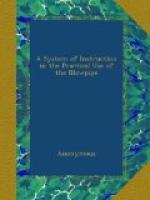For the purpose of acquiring practice, the student may fuse the oxide of manganese with borax, upon a platinum wire, in the oxidation flame, when a violet-red glass will be obtained; or if too much of the oxide be used, a glass of a dark color and opaque will be obtained. By submitting this glass to the reduction flame, it will become colorless in correspondence to the perfection with which the flame is produced. Or a piece of tin may be fused upon charcoal, and kept in that state for a considerable time, while it presents the appearance of a bright metal on the surface. This will require dexterity in the operator; for, if the oxidation flame should chance to touch the bright metal only for a moment, it is coated with an infusible oxide.
COMBUSTION.—Any flame of sufficient size can be used for blowpipe operations. It may be either the flame of a candle of tallow or wax, or the flame of a lamp. The flame of a wax candle, or of an oil lamp is most generally used. Sometimes a lamp is used filled with a solution of spirits of turpentine in strong alcohol. If a candle is used, it is well to cut the wick off short, and to bend the wick a little toward the substance experimented upon. But candles are not the best for blowpipe operations, as the radiant heat, reflecting from the substance upon the wax or tallow, will cause it to melt and run down the side of the candle; while again, candles do not give heat enough. The lamp is much the most desirable. The subjoined figure, from Berzelius, is perhaps the best form of lamp. It is made of japanned tin-plate, about four inches in length, and has the form and arrangement represented in Fig. 5. K is the lamp, fastened on the stand, S, by a screw, C, and is movable upwards or downwards, as represented in the figure. The posterior end of the lamp may be about one inch square, and at its anterior end, E, about three-quarters of an inch square. The under side of this box may be round, as seen in the figure. The oil is poured into the orifice, A, which has a cap screwed over it. C’ is a wickholder for a flat lamp-wick. a is a socket containing the wick, which, when not in use, is secured from dirt by the cap. The figures B and a’ give the forms of the cap and socket. The best combustible for this lamp is the refined rape-seed oil, or pure sweet oil. When this lamp is in use, there must be no loose threads, or no charcoal on the wick, or these will produce a smoky flame. The wick, likewise, should not be pulled up too high, as the same smoky flame would be produced.
[Illustration: Fig. 5]
THE SPIRIT-LAMP.—This is a short, strong glass lamp, with a cap, B, Fig. 6, fitted to it by grinding, to prevent the evaporation of the alcohol. The neck a contains a tube C, made of silver, or of tin plate, and which contains the wick. Brass would not answer so well for this tube, as the spirits would oxidize it, and thus impart color to the flame. The wickholder must cover the edge of the neck, but not fit tight within the tube, otherwise, by its expansion, it will break the glass. It is not necessary that alcohol, very highly rectified, should be burnt in this lamp, although if too much diluted with water, enough heat will not be given out. Alcohol of specific gravity 0.84 to 0.86 is the best.




